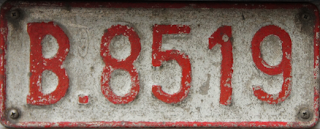OverviewFor each style I will try to show a picture of the given style in each of the codes (if they have ever existed in that format). There are several criteria to recognize a plate style:
1. 1953 style
2. 1973 style
3. 1997 style
4. 1999 style
5. 2008 style
6. 2010 style
| Criterion | 1953 style | 1973 style | 1997 style | 1999 style | 2008 style | 2010 style |
| Dimensions (in millimeters) | 275 x 110 | 340 x 110 | 340 x 110 | 340 x 110 | 340 x 110 | 520 x 110 |
| Background | Not applicable | Reflective | Reflective | Reflective | Reflective | Reflective |
| Separating character(s) | Dot | Dot | Dash | Dash | Dash | Dash |
| Place of the separating character(s) on 5-character plates | Lower line | Lower line | Lower line | Lower line | Middle line | Middle line |
| Place of the separating character(s) on 6-character plates | Not applicable | Middle line | Middle line | Middle line | Middle line | Middle line |
| CV sceal | Unpainted | Unpainted | Unpainted | Painted | Painted | Painted |
| Hologram with lions | None | None | Yes | Yes | Yes | Yes |
| DIV sceal | None | None | None | Yes | Yes | Yes |
| DIV thread | None | None | None | None | None | Yes |
In the light of the above table, let us now compare the six plate styles with help of Code 1 B-plates (originally the first plates in Belgium) and of vanity plates:
| Style | 5-character plates | 6-character (vanity) plates |
| 1953 |  | [Did not exist in that style.] |
| 1973 |  |  |
| 1997 |  |  |
| 1999 |  |  |
| 2008 |  |  |
| 2010 | [Picture not yet available.] |  |
The table contains the licence plates which I have photographed; they are classified according to their style, then to the code to which they belong. Below the table you find several notes about some of the plates.
Notes:
- B.0006 is a code 1 plate, a duplicate probably made in the 1990s. Seen in Leuven on 30 August 2009. Note that this is the lowest number that I have ever seen – the very first issued number in 1953 being B.0001.
- 55WK.8: note that the separating dot between 55 and WK is missing, which constitutes a rare instance of mistake (compare with the code 8 plates above). Another mistake which I once observed was a S upside down (since the lower half of the S is longer). Such mistakes only occur on duplicates.
- FUC-074: normal series issued originally in the mid 1980s. Note that the FUC plates were not forbidden although they are in some countries for resembling the 'F word'.
- B.0060, B.0209 and C.5050 are vanity plates.
- KC.001 is a vanity plate.
- SAG-119: I'm not 100% sure whether this is a duplicate plate, but since the CV seal was upside down, just as the DIV seal, and both on inverted places, I think it might be an error from when the place was duplicated, although I forgot to check the plate's year of fabrication when I took the picture.
 On this picture taken with a flash, we see more clearly that the DIV sceal is not anymore in the middle of the plate, but under the dash below the CV sceal.
On this picture taken with a flash, we see more clearly that the DIV sceal is not anymore in the middle of the plate, but under the dash below the CV sceal.- 469-BB: there seems to have been a slight problem because there is a larger space to the left of the registration than to its right; compare with other code 9 plates above.
Old text:
1. 1953 style: 270 mm x 110 mm red on white plates.
2. 1973 style: 340 mm x 110 mm red on white reflecting plates, with separating period on the lower horizontal line of the plate for 5-character plates, or in the centre of the plate for the 6-character plates.
4. 1999 style: 340 mm x 110 mm red on white reflecting plates, with separating dash in the middle of the plate, hologram with year of issue along the vertical middle line, and official CV sceal painted the same colour as the edge.
5. 2008 style: 340 mm x 110 mm red on white reflecting plates, with separating dash in the middle of the plate, hologram with year of issue along a vertical line passing behind the CV sceal, official CV sceal painted the same colour as the edge, letters and digits closer to one another; each separating dash is made on a larger die, and is located on the horizontal middle line of the plates (whereas it was towards the bottom previously).
6. 2010 style (upcoming, due for 16 November 2010): 520 mm x 110 mm ruby red on white plates, hologram with year of issue, official CV sceal painted the same colour as the edge; the separating dashes are on larger dies and are located on the middle line of the plates, and a blue Euroband with the B monogram and a circle of twelve European stars is added on the left side; DIV thread on the right of the Euroband.











































































































































































































